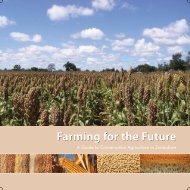Restoring the Soil - Canadian Foodgrains Bank
Restoring the Soil - Canadian Foodgrains Bank
Restoring the Soil - Canadian Foodgrains Bank
Create successful ePaper yourself
Turn your PDF publications into a flip-book with our unique Google optimized e-Paper software.
44Decision Tree Guidegrow well and effectively control weedsgiven <strong>the</strong> local conditions of altitude andweed pressure. The three varieties/speciesare bushy-type jackbean, climbing jackbeanor swordbean and tephrosia (ei<strong>the</strong>rTephrosia vogelii or T. candida). A week ortwo before <strong>the</strong> beginning of <strong>the</strong> first rainyseason in <strong>the</strong> fallow period, broadcast <strong>the</strong>seed of both varieties of jackbean and <strong>the</strong>tephrosia. The jackbean seed (Photo 20)should be sown at a rate of about threeseeds per square metre and <strong>the</strong> tephrosiaabout one to two seeds per square metre.The jackbean (Canavalia ensiformis - whiteseed) and its close relative, <strong>the</strong> swordbean(Canavalia gladiatus - red seed), are by far22. Honduras. Tephrosia is most widely used as <strong>the</strong> most drought resistant gm/cc speciesa temporary shade for coffee, but has tremendous used, even when just a week or two oldpotential as a smallholder gm/cc crop where (Photo 21). They are also <strong>the</strong> most resistantto poor soils, and grow well in moder-uncontrolled grazing is practiced. Being poisonous,animals will not bo<strong>the</strong>r it.ate shade. The jackbean can fix up to 240kg N/ha each year, so where nitrogen is<strong>the</strong> limiting factor, soil fertility will increase rapidly in one year. Fur<strong>the</strong>rmore, like<strong>the</strong> tephrosia, jackbean can grow through much or all of <strong>the</strong> dry season, greatlyreducing <strong>the</strong> nitrogen loss problem.Both species of tephrosia are woody-stemmed bushes that will reach three orfour metres in height under good growing conditions. The tephrosias are verydrought-resistant, but usually don’t grow well below 300 to 400 m of elevation.Because <strong>the</strong>y are poisonous, animals will not eat <strong>the</strong>m except under conditionsof serious drought (Photo 22). 14 Tephrosia plants will die after about four years,but <strong>the</strong> soil is generally fertile before <strong>the</strong>n. African farmers who use ei<strong>the</strong>r of <strong>the</strong>tephrosias as an improved fallow usually cut it down and kill it after only one ortwo years, because <strong>the</strong> soil is ready for cropping by that time. Weed control isusually very good if it is sown thickly, as mentioned above. Tephrosia can be usedto make an insecticide. If tephrosia is <strong>the</strong> best fit, see S60, <strong>the</strong>n go to #5.30. Are animals let loose during <strong>the</strong> off season? Are <strong>the</strong> domestic animals (cattle,sheep or goats) let loose when crops are not in <strong>the</strong> fields? If so, go to #31. If not,or if <strong>the</strong>re are no grazing animals in <strong>the</strong> villages, go to #32.31. Improved fallows where <strong>the</strong> animals are loose. Here <strong>the</strong> best species are <strong>the</strong>two tephrosia species and <strong>the</strong> jackbean. As with <strong>the</strong> tephrosias, <strong>the</strong> jackbean maybe attacked by animals if <strong>the</strong>y are very hungry, but this rarely occurs in areas with14See, for instance, Cherry, Stefan, “Tephrosia fallow management in Cameroon,” in ECHO Development Notes, Issue #65,1999.
















